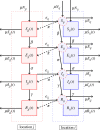High connectivity and human movement limits the impact of travel time on infectious disease transmission
- PMID: 38196378
- PMCID: PMC10777149
- DOI: 10.1098/rsif.2023.0425
High connectivity and human movement limits the impact of travel time on infectious disease transmission
Abstract
The speed of spread of severe acute respiratory syndrome coronavirus 2 (SARS-CoV-2) during the coronavirus disease 2019 (COVID-19) pandemic highlights the importance of understanding how infections are transmitted in a highly connected world. Prior to vaccination, changes in human mobility patterns were used as non-pharmaceutical interventions to eliminate or suppress viral transmission. The rapid spread of respiratory viruses, various intervention approaches, and the global dissemination of SARS-CoV-2 underscore the necessity for epidemiological models that incorporate mobility to comprehend the spread of the virus. Here, we introduce a metapopulation susceptible-exposed-infectious-recovered model parametrized with human movement data from 340 cities in China. Our model replicates the early-case trajectory in the COVID-19 pandemic. We then use machine learning algorithms to determine which network properties best predict spread between cities and find travel time to be most important, followed by the human movement-weighted personalized PageRank. However, we show that travel time is most influential locally, after which the high connectivity between cities reduces the impact of travel time between individual cities on transmission speed. Additionally, we demonstrate that only significantly reduced movement substantially impacts infection spread times throughout the network.
Keywords: connectivity; epidemiological models; human mobility; infectious disease outbreaks; respiratory diseases.
Conflict of interest statement
We declare we have no competing interests.
Figures








References
Publication types
MeSH terms
Associated data
LinkOut - more resources
Full Text Sources
Medical
Miscellaneous

